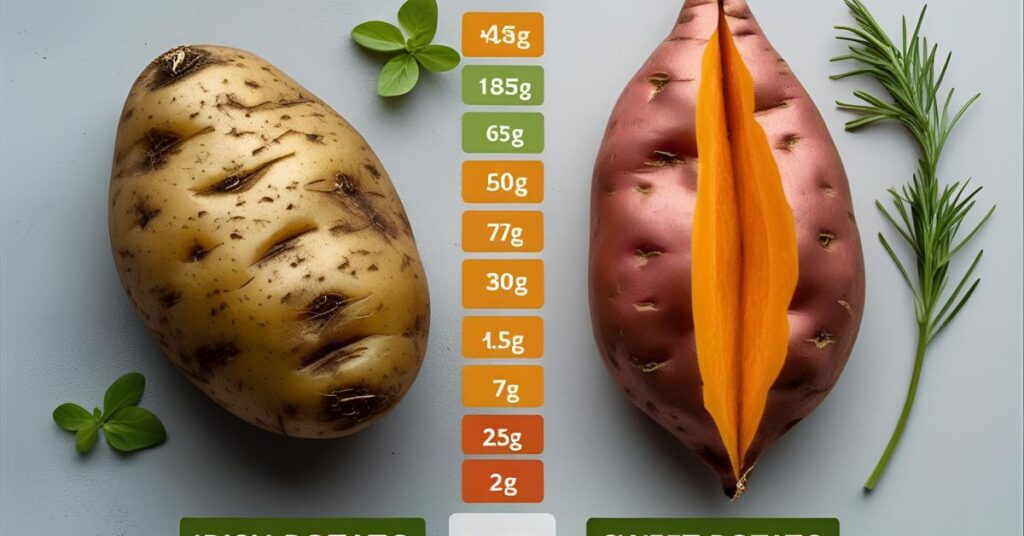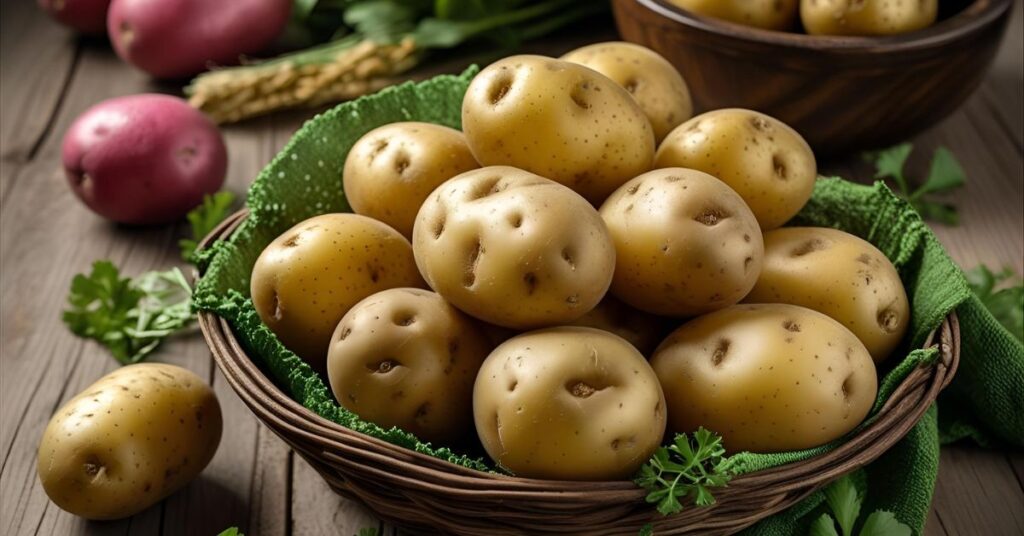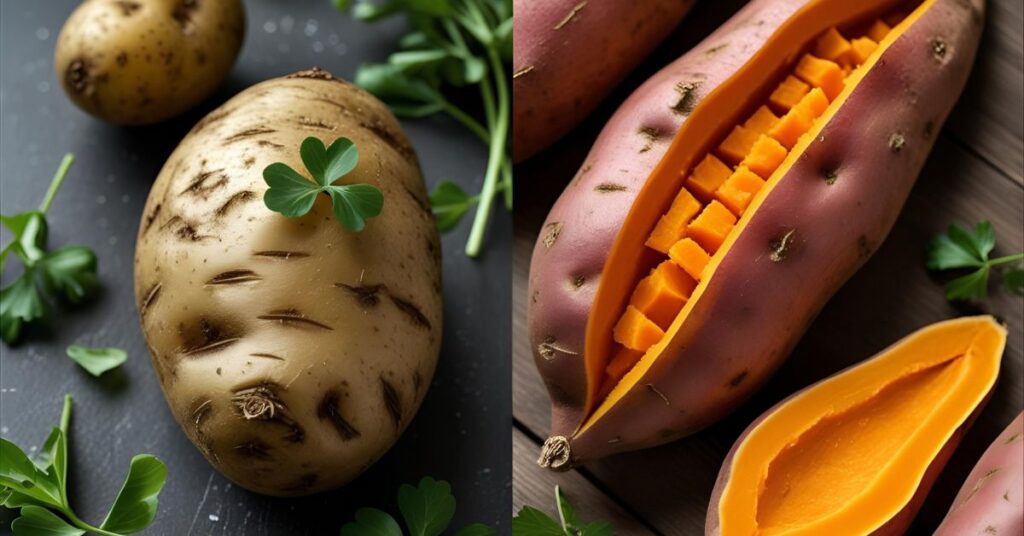When it comes to choosing the right carbs for a balanced diet, potatoes are often at the center of the conversation. Two of the most commonly consumed varieties—sweet potato vs potato nutrition—might look similar at first glance, but they differ significantly in taste, texture, nutritional value, and health benefits. Whether you’re managing your blood sugar, attempting to reduce weight or just making a healthier food choice, knowing the differences between these two popular tubers can help you make smarter dietary choices.
In this article, we’ll explore Irish Potato vs Sweet Potato: Which Is Healthier for Your Diet? From calorie content and glycemic index to vitamins and overall health benefits, we’ll compare both potatoes side by side to see which one truly earns the title of the better-for-you spud.
What Is an Irish Potato?
An Irish potato typically refers to the white or yellow-fleshed varieties of potato, such as Russet or Yukon Gold. These starchy tubers are a staple in many Western diets and have been cultivated for centuries as a versatile and affordable food source. Despite the name, irish sweet potatoes aren’t native to Ireland—they originally come from South America and were introduced to Europe in the late 1500s. However, they became deeply rooted in Irish cuisine and agriculture, which is how the name originated.
Irish potatoes are most commonly used in mashed, baked, roasted, or fried dishes and are loved for their fluffy texture and mild, earthy flavor. They’re also a key ingredient in popular comfort foods like mashed potatoes, French fries, potato salad, and shepherd’s pie.
Nutritionally, Irish potatoes provide approximately 77 calories per 100 grams. They are a good source of:
- Vitamin C – Promotes skin health and immunological function.
- Vitamin B6 – helps with energy metabolism and brain development
- Potassium is necessary for both muscle and heart health.
- Dietary fiber promotes digestive health and satiety
Although sometimes viewed as a “fattening” food, Irish potatoes are nutrient-dense and can be part of a healthy diet when prepared in wholesome ways (think baking or boiling instead of deep-frying).
What Is a Sweet Potato?

A sweet potato is a naturally sweet, nutrient-rich root vegetable known for its vibrant orange flesh, which is high in beta-carotene, a powerful antioxidant that the body converts into vitamin A. While the orange variety is the most common, sweet potatoes also come in purple and white-fleshed varieties, each with distinct tastes and health advantages. Despite the name, sweet potatoes are not directly related to regular (Irish) potatoes and belong to a different plant family.
Is sweet potato better than potato? The texture of sweet potatoes is creamy, and they have a unique, natural sweetness, making them incredibly versatile in the kitchen. They are enjoyed in both savory and dessert recipes, including baked sweet potatoes, roasted wedges, casseroles, soups, and even sweet potato pie or muffins.
In terms of nutrition, sweet potatoes contain approximately 86 calories per 100 grams. They’re packed with essential nutrients such as:
- Vitamin A (beta-carotene) – crucial for eye health, immunity, and skin
- Vitamin C – promotes collagen synthesis and immunological function.
- Potassium aids in controlling muscular contractions and fluid equilibrium.
- Dietary fiber aids digestion and promotes fullness
Sweet potatoes are not only delicious but also deliver a range of health benefits, making them a wise choice for those looking to add more nutrient-dense foods to their diet.
Curious about fruit behavior? Learn why do bananas split and how it affects freshness and shelf life.
Nutritional Comparison Table (Irish Potato vs Sweet Potato)

To determine which potato variety is better for your diet, it’s helpful to look at their nutritional profiles side by side. While both Irish potatoes and sweet potatoes are excellent sources of carbohydrates and essential nutrients, their vitamin content, fiber levels, and glycemic impact vary considerably.
Here’s a breakdown of their nutritional values per 100 grams:
| Nutrient (per 100g) | Irish Potato | Sweet Potato |
|---|---|---|
| Calories | ~77 kcal | ~86 kcal |
| Carbs | 17g | 20g |
| Sugar | 0.8g | 4.2g |
| Fiber | 2.2g | 3.0g |
| Vitamin A | 0 IU | 14,187 IU |
| Vitamin C | 19.7mg | 2.4mg |
| Potassium | 429mg | 337mg |
| Glycemic Index (GI) | High (~85) | Medium (~61) |
Note: These figures are estimates that may change depending on the variety and preparation method.
From the table, it’s clear that sweet potatoes are significantly higher in vitamin A and fiber, making them a strong choice for those seeking better digestion and eye health. On the other hand, Irish potatoes provide more vitamin C and potassium, which support immune function and heart health. The lower glycemic index of carbs in sweet potato vs potato also makes them a more suitable option for managing blood sugar levels.
Glycemic Index & Blood Sugar Impact
A system of rankings known as the glycemic index (GI) gauges how rapidly a food high in carbohydrates raises blood sugar levels after ingestion. A scale of 0 to 100 is used to rank foods:
- High-GI foods (70 and above) cause rapid spikes in blood sugar.
- Medium-GI foods (56–69) have a moderate effect.
- Low-GI foods (55 and below) lead to a slower, more gradual rise.
This is especially important for people managing diabetes, insulin resistance, or those aiming to maintain steady energy levels throughout the day.
When it comes to potatoes, Irish potatoes tend to have a high glycemic index of around 85, which means they are digested and absorbed swiftly, leading to sharp rises in blood sugar levels. This can be especially problematic for those with diabetes or trying to lose weight because it can lead to energy crashes, a rise in appetite shortly after eating, and potential blood sugar abnormalities.
On the other hand, sweet potatoes have a lower GI, around 61, making them a better option for blood sugar control. Their higher fiber content helps slow down digestion, resulting in a slower rate of blood glucose absorption. As a result, sweet potato vs regular potato are often preferred for weight management, sustained energy, and diabetic-friendly diets.
Health Benefits of Irish Potatoes
Despite their reputation as a starchy carb, Irish potatoes offer several valuable health benefits when consumed in moderation and prepared healthily (e.g., baked or boiled instead of fried). These standard white or yellow potatoes are more than just a comfort food staple—they’re packed with nutrients that support overall wellness.
One of the standout benefits of Irish potatoes is their high potassium content. With approximately 429mg of potassium per 100g, they help regulate blood pressure, support heart function, and maintain fluid balance in the body. Consuming enough potassium is associated with a lower risk of cardiovascular disease.
Irish potatoes are also a good source of Vitamin C, offering about 19.7mg per 100g. This essential antioxidant strengthens the immune system, facilitates the body’s iron uptake from plant-based diets, and promotes collagen production for healthy skin.
Additionally, Irish potatoes contain easily digestible carbohydrates, making them an ideal source of quick energy, especially useful for athletes and active individuals. Their starchy nature provides the fuel needed for endurance and recovery, particularly when consumed before or after physical activity.
Irish potatoes can play a valuable role in a balanced diet, offering heart-healthy potassium, immune-boosting Vitamin C, and accessible energy for daily performance.
Wondering how to tell citrus fruits apart? This article on clementine vs mandarin explains it clearly.
Health Benefits of Sweet Potatoes
Sweet potatoes vs potatoes are often praised as a superfood, and for good reason. Rich in essential nutrients and antioxidants, they offer they are a great complement to any well-balanced diet because of their many health advantages.
One of the most notable features of sweet potatoes is their high content of beta-carotene, the plant pigment that gives them their vibrant orange color. The body converts beta-carotene into vitamin A, which is crucial for maintaining healthy vision, glowing skin, and a strong immune system. Just 100 grams of sweet potato can provide more than 400% of your recommended daily intake of vitamin A.
Furthermore, sweet potatoes are a fantastic source of nutritional fiber, especially when consumed with the skin. This fiber content helps support digestion, promotes gut health, and contributes to regular bowel movements. A fiber-rich diet can also aid in reducing cholesterol levels and improving overall metabolic health.
In addition, sweet potatoes contain anti-inflammatory compounds, such as anthocyanins (especially in purple varieties), which may aid in reducing the body’s inflammation and guard against long-term illnesses, including heart disease and certain cancers.
Another significant benefit is their lower glycemic index, which means their carbohydrates are absorbed more slowly. Consequently, blood sugar levels stabilize, longer-lasting satiety and sustained energy, making white sweet potato nutrition a wise choice for weight management and diabetic-friendly meals.
In short, sweet potatoes offer a potent mix of eye-protecting vitamin A, gut-supporting fiber, natural anti-inflammatory effects, and steady energy release, making them a true nutritional powerhouse.
Which Is Better for Specific Diet Goals?

When it comes to choosing between Irish potatoes and sweet potatoes, the “healthier” option often depends on your individual dietary goals. Each variety offers unique nutritional benefits, making one more suitable than the other depending on your goals.
For Weight Loss:
Sweet potatoes are a better choice for those looking to shed pounds. Their higher fiber content helps promote fullness and reduce appetite. At the same time, their lower glycemic index means they release energy more slowly, preventing cravings may result from blood sugar falls and increases.
For Athletes:
If you need quick fuel for workouts or recovery, Irish potatoes are ideal. They provide easily digestible carbohydrates, which are perfect for rapid energy replenishment before or after physical activity. Their high potassium content also supports muscle function and hydration.
For Diabetics:
Sweet potatoes are generally preferred for people managing diabetes. Their slower carbohydrate absorption and medium glycemic index assist maintain more consistent blood sugar levels as opposed to the high-GI Irish potato, reducing the risk of sudden glucose spikes.
For General Health:
While both types offer health benefits, sweet potatoes edge ahead for overall wellness. Their rich supply of beta-carotene (vitamin A), antioxidants, and fiber makes them a more potent ally in supporting eye health, immunity, and long-term disease prevention.
In summary, both Irish and sweet potatoes can fit into a healthy diet, but your specific health goals will determine which one is the better fit.
Cooking & Usage Differences
Irish potatoes and sweet potatoes each bring their unique flavors and textures to the kitchen, making them suited to different cooking methods and dishes.
Irish potatoes are incredibly versatile and work best when fried, mashed, or roasted. Their starchy, fluffy texture makes them ideal for crispy French fries, creamy mashed potatoes, or golden roasted wedges. Because of their neutral flavor, Irish potatoes easily complement a wide range of savory dishes and seasonings.
On the other hand, sweet potatoes shine when baked, boiled, or used in dessert-based recipes. Their natural sweetness intensifies with baking, making them perfect for dishes like baked sweet potato fries, casseroles, or even sweet treats such as pies and muffins. Boiling sweet potatoes softens their flesh, making them ideal for purees and soups.
For the healthiest results, it’s best to avoid frying either type of potato frequently, as frying significantly increases calorie and fat content. Instead, opt for baking, boiling, steaming, or roasting methods to retain nutrients and enjoy their natural flavors with less added fat.
By understanding these cooking and usage differences, you can better incorporate Irish and sweet potatoes into your meals to maximize both taste and health benefits.
Are Sweet Potatoes Healthier Than Regular Potatoes

Are sweet potatoes better than regular potatoes? Yes, sweet potatoes are generally considered healthier than regular (Irish) potatoes, especially when comparing their nutritional density and impact on blood sugar. Here’s a quick breakdown of why:
Reasons Sweet Potatoes Are Considered Healthier:
- Higher in Vitamin A (Beta-Carotene): Sweet potatoes are abundant in beta-carotene, which is transformed by your body into vitamin A, essential for eye health, immunity, and skin. Regular potatoes contain almost none.
- More Fiber: Sweet potatoes contain slightly more dietary fiber, which helps with digestion, fullness, and blood sugar control.
- Lower Glycemic Index (GI): Sweet potatoes have a moderate GI (~61) compared to Irish potatoes’ high GI (~85), meaning they cause slower, more stable blood sugar increases—better for diabetics and weight management.
- Antioxidants: Sweet potatoes, especially the orange and purple varieties, contain more antioxidants, which help reduce inflammation and fight oxidative stress.
But It Depends on Your Goals:
- Need fast energy? Regular potatoes may be better because they’re more rapidly digested.
- Trying to manage blood sugar or lose weight? Sweet potatoes are a better choice.
- Looking for immune or skin health benefits? Sweet potatoes win due to their high vitamin A content.
Conclusion:
When it comes to Irish potato vs sweet potato, there’s no one-size-fits-all answer. Both potatoes offer unique nutritional benefits and culinary uses that can fit different dietary needs and preferences.
Suppose your priority is to manage blood sugar levels or boost your intake of vitamins and antioxidants. In that case, sweet potatoes are the healthier choice thanks to their lower glycemic index and rich nutrient profile, especially their high vitamin A content.
However, if you’re looking for quick energy or a potato that adapts well to a variety of cooking methods—from frying to mashing—Irish potatoes remain a versatile and satisfying option.
In the end, balance is the key to a healthy diet and variety. Incorporating both Irish and sweet potatoes into your meals enables you to take advantage of both advantages while benefiting from their different flavors, textures, and nutrients. Choose the potato that best fits your health goals, cooking style, and taste preferences to create a delicious and nourishing diet.
FAQs:
1. How do Irish potatoes and sweet potatoes differ from one another?
Irish potatoes are typically white or yellow-fleshed and starchy, while sweet potatoes have an orange, purple, or white flesh and are naturally sweeter with higher beta-carotene content.
2. Which potato is healthier, the Irish potato or the sweet potato?
Sweet potatoes are generally considered healthier due to their higher fiber, vitamin A content, and lower glycemic index, making them better for blood sugar control and overall nutrition.
3. Can people with diabetes eat Irish potatoes or sweet potatoes?
Sweet potatoes are a better option for people with diabetes because they cause slower blood sugar spikes due to their lower glycemic index compared to Irish potatoes.
4. Are sweet potatoes better for weight loss?
Yes, sweet potatoes are often preferred for weight loss due to their lower glycemic index and increased fiber content, which promotes satiety and blood sugar management.
5. How do Irish potatoes and sweet potatoes differ in cooking?
Irish potatoes are great for frying, mashing, and roasting, while sweet potatoes work well baked, boiled, or in dessert recipes.





